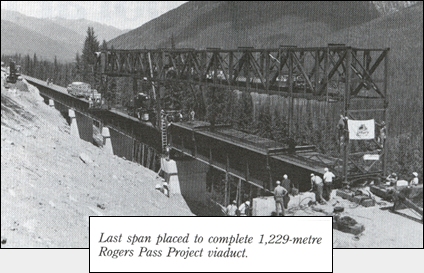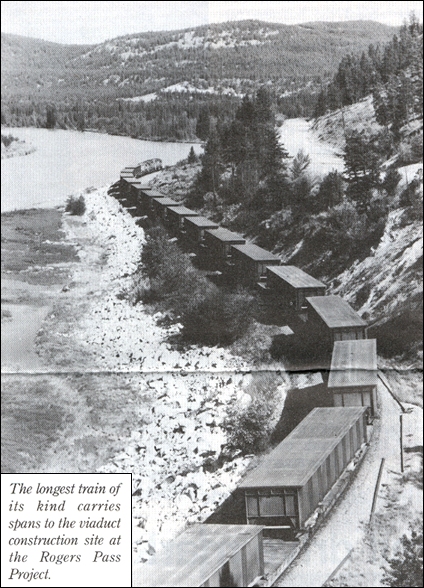Vol. 17 No. 8
August, 1987
|
Stay Safe in 87
|
|
Foreman's Yell
Signals Viaduct's Completion
By Steve
Morris

ROGERS PASS B.C. - Some were perched on the slopes. Many
decided to hang over the steel superstructure. A few stood patiently on the abutment.
But they'd all come for one purpose.
And at 12:50 p.m., 25 Jun 1987, under sunny skies it started to happen.
With a yell from the foreman, the crews from Dominion Bridge began maneuvering the last of 45 steel bridge spans into
place on the Rogers Pass Project's 1,229-metre viaduct.
Not only did the last span mark the completion of the viaduct, the main feature of the surface route portion of the
33-kilometre mega-project, it also signalled the last of six bridges to be installed on the
project.
"It was quite a day", said John Fox, vice-president engineering special projects. "When
we began clearing trees and putting in an access road to build the viaduct back in 1983 and 1984, seeing the
completed structure seemed so far away".
The viaduct, which consists of 44 piers, two abutments, and 45 spans, stretches along 40-degree slopes
near the top of the Beaver Valley at the east end of Rogers Pass. It begins just west of Stoney Creek Bridge and ends
a few metres from the east portal of the 1.8-kilometreMount Shaughnessy Tunnel.
EACH PIER WAS CUSTOM-DESIGNED
Because of the rugged terrain, each pier had to be custom-designed.
"The complex construction involved using techniques sometimes foreign to railway construction", said Greg
Hamilton, project engineer. The piers had to be secured into the soil using grouted threadbar, ground anchor piles
which extended nine metres into the ground. They provide the ground support for the pier".
Work on the viaduct began in early 1985. The last pier was completed in the fall of 1986 but, because of the severe
climate in Rogers Pass, installation of the spans could not be done until this spring.
With an average annual snowfall of more than 10 metres, the surface route construction season is limited to
mid-April until October.
And, because the project is mostly within Glacier National Park, the new right-of-way was restricted to
30 metres in width through the viaduct area. This, coupled with the slopes, made a narrow access road the only route
to transport crews, equipment, and supplies.
"The narrow access road certainly provided a challenge for the construction crews working on the piers",
said Norm Tennock, project manager.
Transporting the spans to the site was yet another challenge.
"Because the spans were a dimensional load and would not fit through the Spiral Tunnels on the main line, we
had to detour the shipment south from Calgary and through the Crowsnest Pass. Near Cranbrook, the train then swung
back north into golden rejoining the main line there for the final leg".
Two special trains were assembled. The first to leave for the Pass in early May was the longest of its kind in
Canadian railway history.

Once the spans arrived, then began a three-step process to install them.
Again because of the terrain, a system was devised whereby a locomotive would move one span from Wakely siding on
the new line to the end of track on the west end of the Stoney Creek Bridge.
From there the span was transferred onto a large flatbed truck with rear wheels that could be steered. The truck
then backed along about half a kilometre of the unfinished roadbed to the viaduct.
The truck then positioned itself beneath a specially-built machine called a launcher. The launcher
lifted a span off the truck and fed it forward over the piers ahead.
As the process continued, the truck would back over the installed span to the launcher's new position. The launcher
moved from pier to pier along the completed spans on wheels that were anchored to the sides.
The first span was installed on 26 May 1987 and the last at 13:15 hours, 25 Jun 1987.
During a small ceremony to mark the occasion, Mr. Fox summed up the feeling of the day.
"For the men and women this day has a special meaning. They feel part of an historic event that has just as much
drama for them as it was for the construction workers who built the original line some 100 years
ago".
This CP Rail News article is copyright
1987 by the Canadian Pacific Railway and is reprinted here with
their permission. All photographs, logos, and trademarks are the property of the Canadian Pacific Railway
Company.
|